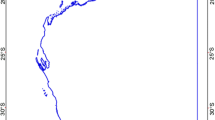Summary
The hypothesis that increasing the plant population of guayule (Parthenium argentatum) to compensate for the reduced plant canopy size caused by soil salinity coupled with an anticipated enchancement of rubber production under the moderate environmental stress imposed by salinity was tested in a field plot experiment in the Imperial Valley of California. Irrigation waters having electrical conductivities (EG i ) of 1.2, 3.2, 6.5, and 9.4 dS/m were applied for 4 years to plots having plant populations of 28,000, 56,000, and 84,000 plants per hectare. The influence of salinity on rubber and resin production was independent of plant population. The salt tolerance threshold, maximum average salinity level of the root zone measured as the electrical conductivity of saturated soil extracts (\(\overline{\overline {{\text{EC}}}} _e \)) without yield reduction, was 7.5 dS/m; beyond this threshold, rubber production was reduced 6.1% per unit increase of soil salinity. The salinity values were averaged through the root zone from planting to harvest. The average rubber content — 7.9% — was altered little by treatment or harvest age for 2- to 4-year-old plants. Resin content averaged 8.4% but increased salinity and increased plant population increased the resin content slightly in some cases. Dry matter production of shoots for the nonsaline treatment was 259 kg/ha/month for pollarded (clipped) shoots after 31 months, 203 kg/ha/month for shoots harvested after 43 months, and 401 kg/ha/month for the 24-month period after pollarding. Combining the shoot mass after 31 and 55 months gave an average growth rate of 321 kg/ha, supporting the recommendation for pollarding. Monthly growth rates for the lowest salt treatment (3.2 dS/m) were about 10% less than for the nonsaline treatment (1.2 dS/m). The hypothesis tested was proven to be false because neither increased salinity nor increased plant population increased rubber production.
Similar content being viewed by others
References
Benedict HM, McCary WL, Slattery MC (1947) Response of guayule to alternating periods of low and high moisture stress. Bot Gaz 100:535
Black LT, Hamerstrand GE (1985) Determination of rubber, resin, and moisture in guayule: Gravimetric calibration analysis and the use of near infrared reflectance spectroscopy. El Guayulero 7:10
Bucks DA, Nakayama FS (1986) Water management and production relations of mature guayule. Fangmeier DD, Alcorn SM (eds) Proc 4th Int Guayule Res & Dev Conf, Guayule Rubber Soc Inc, p 415
Bucks DA, Roth RL, Nakayama FS, Gardner BR (1985) Irrigation water, nitrogen, and bioregulation for guayule production. Trans ASAE 28:1196
Bucks DA, Nakayama FS, French OF (1984) Water management for guayule rubber production. Trans ASAE 27:1763
Cornforth GC, Lacewell RD, Collins GS, Whitson RE, Hardin DC (1980) Guayule — economic implications of production in the Southwestern United States. Texas Agric Exp Stn Bull MP-1466
Fangmeier DD, Rubis DD, Taylor BB, Forter KE (1984) Guayule for rubber production in Arizona. Tech Bull 252, Agric Exp Stn, University of Arizona, Tucson
Fangmeier DD, Samani Z, Garrot D, Ray DT (1985) Water effects on guayule rubber production. Trans ASAE 28:1947
Francois LE (1982) Narrow row cotton (Gossypium hirsutum L.) under saline conditions. Irrig Sci 3:149
Hammond BC, Polhamus LG (1965) Research on guayule (Parthenium argentatum): 1942–1959. US Dept Agric Tech Bull 1327
Maas EV, Donovan TJ, Francois LE, Hamerstrand GE (1986) Salt tolerance of guayule. Fangmeier DD, Alcorn SM (eds) Proc 4th Int Guayule Res & Dev Conf. Guayule Rubber Soc Inc, p 101
Maas EV, Hoffman GJ (1977) Crop salt tolerance — current assessment. J Irrig Drain Div ASCE 103 (IR2):115
Mills D, Benzioni A, Forti M (1987) New crops for arid lands: Guayule — A potential source of natural rubber. 5th Annu Rep, Cooperative Arid Lands Agricultural Research Program, Ben-Gurion University, Beer Sheva
Miyamoto S, Davis J, Piela K (1984) Water use, growth, and rubber yields of four guayule selections as related to irrigation regimes. Irrig Sci 5:95
Polhamus LG (1962) Rubber: Botany, production, utilization. Hill, London
Retzer JL, Mogen CA (1947) Soil-guayule relationships. J Am Soc Agron 39:483
Rhoades JD, Ingvalson RD (1971) Determining salinity in field soils with soil resistance measurements. Soil Sci Soc Am Proc 35:54
Tingey DC (1952) Effect of spacing, irrigation, and fertilization on rubber production in guayule sown directly in the field. Agron J 44:298
Wadleigh CH, Gauch HG, Magistad OC (1946) Growth and rubber accumulation in guayule as conditioned by soil salinity and irrigation regime. US Dep Agric Tech Bull 925
Author information
Authors and Affiliations
Rights and permissions
About this article
Cite this article
Hoffman, G.J., Shannon, M.C., Maas, E.V. et al. Rubber production of salt-stressed guayule at various plant populations. Irrig Sci 9, 213–226 (1988). https://doi.org/10.1007/BF00275433
Received:
Issue Date:
DOI: https://doi.org/10.1007/BF00275433




